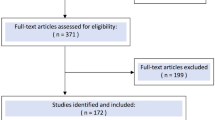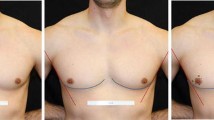Abstract
Background
Mastectomy is performed in female-to-male transsexual (FTM TS) patients as a surgical treatment to make a female thorax resemble a male thorax; however, no studies have examined the nipple-areolar complex (NAC) position in FTM TS patients after mastectomy.
Patients and Methods
The NAC position in 41 FTM TS patients before and after non-skin-excisional mastectomy was examined and compared with that in 50 age- and BMI-matched biologically male subjects as controls. The factors affecting the NAC position after the operation were also examined and verified by multiple regression analysis.
Results and Conclusions
After non-skin-excisional mastectomy, the NAC in the FTM TS patients was positioned significantly more medially (horizontal NAC position ratio {(‘internipple distance’/‘width of thorax’) × 100} [HNPR]: preoperatively, 70.07% ± 4.19%; postoperatively, 63.28% ± 3.79%) and cranially (vertical NAC position ratio {(‘distance from sternal notch to nipple height’/‘distance from sternal notch to umbilicus’) × 100} [VNPR]: preoperatively, 43.87% ± 3.68%; postoperatively, 41.37% ± 3.15%). Postoperatively, the NAC in the FTM TS patients was located significantly more medially than that in the control subjects (HNPR: 63.28% ± 3.79% to 66.79% ± 4.82%), although the height of the NAC was the same. Multiple regression analysis revealed that the NAC position on breasts characterized by ptosis, a high projection, and lateral leaning (low skin elasticity and a substantial amount of skin between the nipples) tended to be positioned more medially after non-skin-excisional mastectomy. Laterally deviated eccentric circular type mastectomy may be a good option for FTM TS patients who have moderately sized breasts with such features.
Level of Evidence IV
This journal requires that authors assign a level of evidence to each article. For a full description of these Evidence-Based Medicine ratings, please refer to the Table of Contents or the online Instructions to Authors www.springer.com/00266.







Similar content being viewed by others
References
World Health Organization (WHO) (2018) International classification of diseases, 11th revision (ICD-11): 17 Conditions related to sexual health.
Zucker KJ (2015) The DSM-5 diagnostic criteria for gender dysphoria. In: Trombetta C, Liguori G, Bertrolotto M (eds) Management of gender dysphoria. Springer, Milan, pp 33–37
Webster JP (1946) Mastectomy for gynecomastia through a semicircular intra-areolar incision. Ann Surg 124(3):557–575
Strombeck JO (1960) Mammaplasty: report of a new technique based on the two-pedicle procedure. Br J Plast Surg 13:79–90
Skoog T (1963) A technique of breast reduction; transposition of the nipple on a cutaneous vascular pedicle. Acta Chir Scand. 126:453–465
Pitanguy I (1966) Transareolar incision for gynecomastia. Plast Reconstr Surg 38(5):414–419
Pitanguy I (1967) Surgical treatment of breast hypertrophy. Br J Plast Surg 20(1):78–85
McKissock PK (1972) Reduction mammaplasty with a vertical dermal flap. Plast Reconstr Surg 49(3):245–252
Letterman G, Schurter M (1972) Surgical correction of massive gynecomastia. Plast Reconstr Surg 49(3):259–262
Regnault P (1974) Reduction mammaplasty by the “B” technique. Plast Reconstr Surg 53(1):19–24
Davidson BA (1979) Concentric circle operation for massive gynecomastia to excise the redundant skin. Plast Reconstr Surg 63(3):350–354
Georgiade NG, Serafin D, Morris R, Georgiade G (1979) Reduction mammaplasty utilizing an inferior pedicle nipple-areolar flap. Ann Plast Surg 3(3):211–218
Góes JC (1996) Periareolar mammaplasty: double skin technique with application of polyglactine or mixed mesh. Plast Reconstr Surg 97(5):959–968
Lindsay WR (1979) Creation of a male chest in female transsexuals. Ann Plast Surg 3(1):39–46
Hage JJ, Bloem JJ (1995) Chest wall contouring for female-to-male transsexuals: Amsterdam experience. Ann Plast Surg 34(1):59–66
Hage JJ, van Kesteren PJ (1995) Chest-wall contouring in female-to-male transsexuals: basic considerations and review of the literature. Plast Reconstr Surg 96(2):386–391
Takayanagi S, Nakagawa C (2006) Chest wall contouring for female-to-male transsexuals. Aesthet Plast Surg. 30(2):206–212 (discussion 213-4)
Monstrey S, Selvaggi G, Ceulemans P, Van Landuyt K, Bowman C, Blondeel P, Hamdi M, De Cuypere G (2008) Chest-wall contouring surgery in female-to-male transsexuals: a new algorithm. Plast Reconstr Surg 121(3):849–859
Namba Y, Watanabe T, Kimata Y (2009) Mastectomy in female-to-male transsexuals. Acta Med Okayama 63(5):243–247
Cregten-Escobar P, Bouman MB, Buncamper ME, Mullender MG (2012) Subcutaneous mastectomy in female-to-male transsexuals: a retrospective cohort-analysis of 202 patients. J Sex Med 9(12):3148–3153
Top H, Balta S (2017) Transsexual mastectomy: selection of appropriate technique according to breast characteristics. Balkan Med J. 34(2):147–155
Beckenstein MS, Windle BH, Stroup RT Jr (1996) Anatomical parameters for nipple position and areolar diameter in males. Ann Plast Surg 36(1):33–36
Beer GM, Budi S, Seifert B, Morgenthaler W, Infanger M, Meyer VE (2001) Configuration and localization of the nipple-areola complex in men. Plast Reconstr Surg. 108(7):1947–1952 (discussion 1953)
Atiyeh BS, Dibo SA, El Chafic AH (2009) Vertical and horizontal coordinates of the nipple-areola complex position in males. Ann Plast Surg 63(5):499–502
Kasai S, Shimizu Y, Nagasao T, Ohnishi F, Minabe T, Momosawa A, Kishi K (2015) An anatomic study of nipple position and areola size in Asian men. Aesthet Surg J. 35(2):NP20–NP27
Yue D, Cooper LRL, Kerstein R, Charman SC, Kang NV (2018) Defining normal parameters for the male nipple-areola complex: a prospective observational study and recommendations for placement on the chest wall. Aesthet Surg J 38(7):742–748
Khan UD (2011) Breast and chest asymmetries: classification and relative distribution of common asymmetries in patients requesting augmentation mammoplastyy. Eur J Plast Surg 34:375–385
Ho Quoc C, Delaporte T, Meruta A, La Marca S, Toussoun G, Delay E (2013) Breast asymmetry and pectus excavatum improvement with fat grafting. Aesthet Surg J 33(6):822–829
Khan UD (2009) Breast augmentation in asymmetrically placed nipple-areola complex in the horizontal axis: lateralisation of implant pocket to offset lateralised nipples. Aesthet Plast Surg 33(4):591–596
Author information
Authors and Affiliations
Corresponding author
Ethics declarations
Conflict of interest
The authors declare that they have no conflicts of interest to disclose:
Ethical Approval
This case–control study was approved by the institutional review board of the participating institutions and conducted in accordance with the Declaration of Helsinki on investigations involving humans.
Informed Consent
Although informed consent was obtained in the form of an opt-out option on the Web site, for the two patients whose photographs were used in the present article, informed consent was obtained from each patient on an individual basis.
Additional information
Publisher's Note
Springer Nature remains neutral with regard to jurisdictional claims in published maps and institutional affiliations.
Rights and permissions
About this article
Cite this article
Kagaya, Y., Shiokawa, I., Karasawa, H. et al. Nipple-Areolar Complex Position in Female-to-Male Transsexuals After Non-skin-excisional Mastectomy: A Case–Control Study in Japan. Aesth Plast Surg 43, 1195–1203 (2019). https://doi.org/10.1007/s00266-019-01409-2
Received:
Accepted:
Published:
Issue Date:
DOI: https://doi.org/10.1007/s00266-019-01409-2




